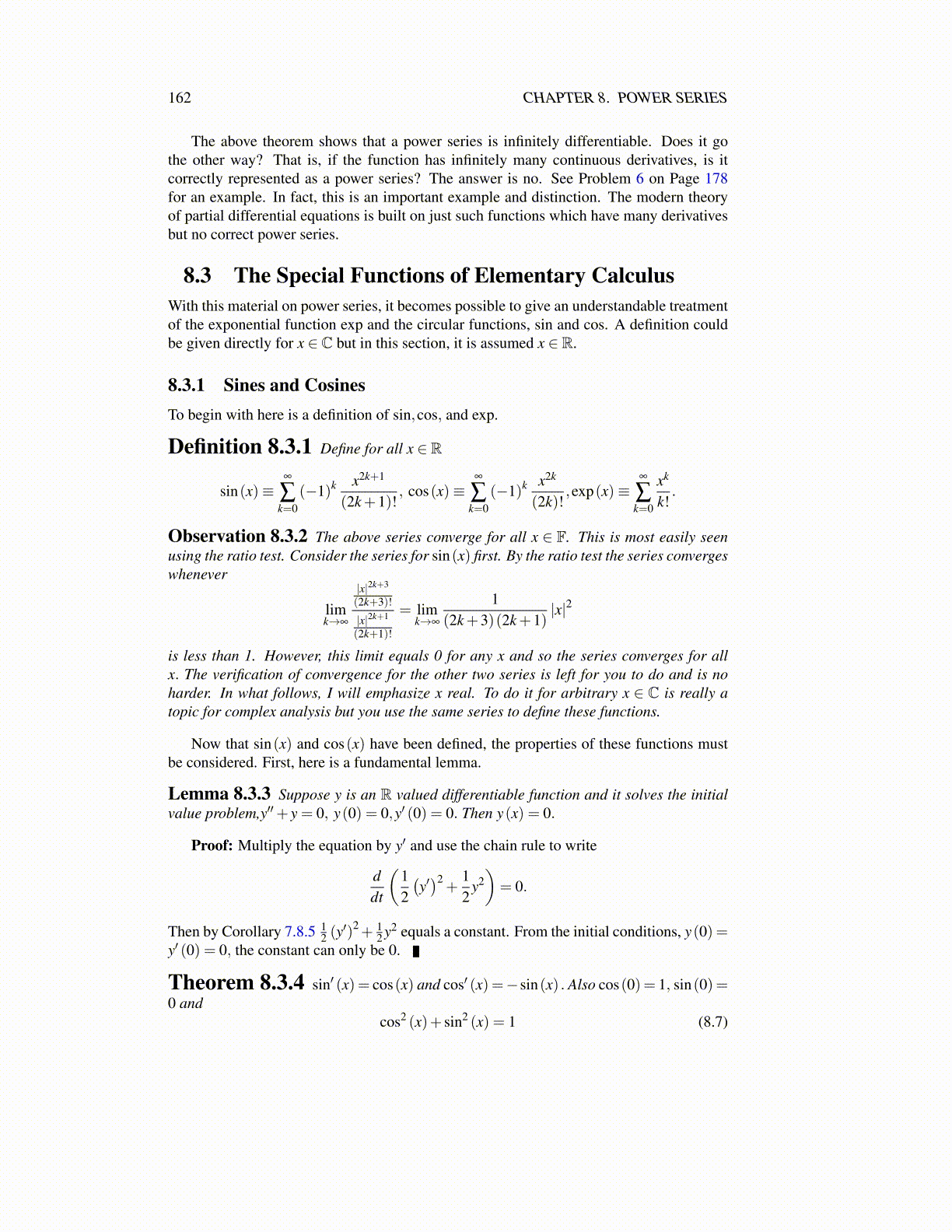
162 CHAPTER 8. POWER SERIES
by Corollary 7.8.6 it would follow that t→ sin t is a strictly increasing function on (0,∞) .Also note that sin(0) = 0 and so sin(x) > 0 for all x > 0. This is because, by the meanvalue theorem there exists t ∈ (0,x) such that
sin(x) = sin(x)− sin(0) = (cos(t))(x−0)> 0.
By 8.7, | f (x)| ≤ 1 for f = cos and sin . Let 0 < x < y. Then from the mean valuetheorem, −cos(y)− (−cos(x)) = sin(t)(y− x) for some t ∈ (x,y) . Since t → sin(t) isincreasing, it follows
−cos(y)− (−cos(x)) = sin(t)(y− x)≥ sin(x)(y− x) .
This contradicts the inequality |cos(y)| ≤ 1 for all y because the right side is unbounded asy→ ∞.
Theorem 8.3.7 Both cos and sin are periodic.
Proof: Define a number π such that π
2 ≡ inf{x : x > 0 and cos(x) = 0} . Then π
2 > 0because cos(0) = 1 and cos is continuous. On
[0, π
2
]cos is positive and so it follows sin is
increasing on this interval. Therefore, from 8.7, sin(
π
2
)= 1. Now from Theorem 8.3.4,
cos(π) = cos(
π
2+
π
2
)=−sin2
(π
2
)=−1, sin(π) = 0
Using Theorem 8.3.4 again,
cos(2π) = cos2 (π) = 1 = cos(0) ,
and so sin(2π) = 0. From Theorem 8.3.4,
cos(x+2π) = cos(x)cos(2π)− sin(x)sin(2π) = cos(x)
Thus cos is periodic of period 2π. By Theorem 8.3.4,
sin(x+2π) = sin(x)cos(2π)+ cos(x)sin(2π) = sin(x)
Using 8.7, it follows sin is also periodic of period 2π.Note that 2π is the smallest period for these functions. This can be seen by observing
that the above theorem and proof imply that cos is positive on(0, π
2
),( 3π
2 ,2π)
and negativeon(
π
2 ,3π
2
)and that similar observations on sin are valid. Also, by considering where these
functions are equal to 0, 1, and -1 along with where they are positive and negative, itfollows that whenever a2 + b2 = 1, there exists a unique t ∈ [0,2π) such that cos(t) = aand sin(t) = b. For example, if a and b are both positive, then since cos is continuous andstrictly decreases from 1 to 0 on
[0, π
2
], it follows there exists a unique t ∈ (0,π/2) such
that cos(t) = a. Since b > 0 and sin is positive on (0,π/2) , it follows sin(t) = b. No othervalue of t in [0,2π) will work since only on (0,π/2) are both cos and sin positive. If a > 0and b < 0 similar reasoning will show there exists a unique t ∈ [0,2π) with cos(t) = a andsin(t) = b and in this case, t ∈ (3π/2,2π) . Other cases are similar and are left to the reader.Thus, every point on the unit circle is of the form (cos t,sin t) for a unique t ∈ [0,2π).
This shows the unit circle is a smooth curve, however this notion will not be consideredhere.